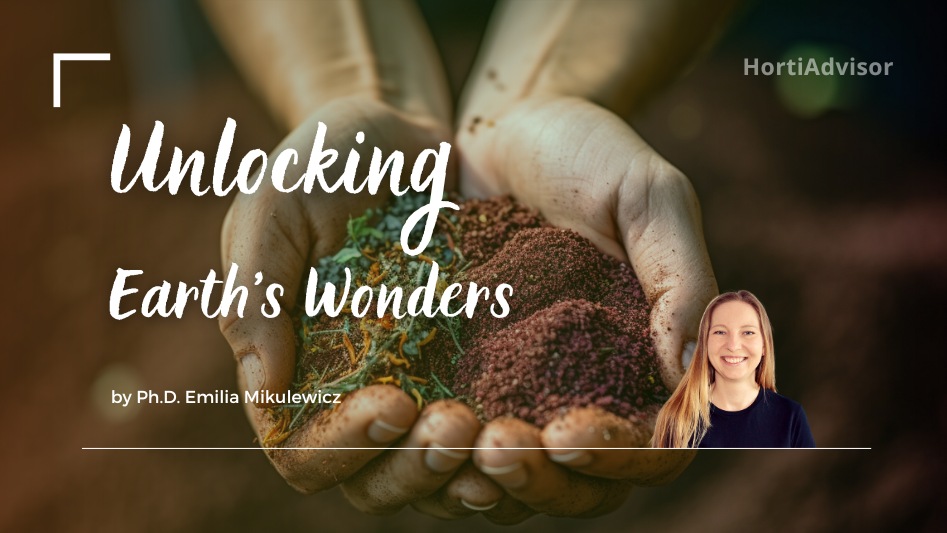Introduction
Soil, the lifeblood of all horticulture, gardening, agronomy, and floristry endeavors, is a dynamic ecosystem teeming with living organisms, organic nutrients, and mineral-rich matter. This complex foundation fosters robust plant roots, influencing plant vitality and health.
Why Understanding Soil Types Is Essential?
As a professional horticulturist, recognizing that soil types aren’t one-size-fits-all is crucial. A firm grasp of soil types enables us to select appropriate plants, optimize their care, and anticipate potential difficulties, ensuring a thriving garden soil.
An Overview of the Different Soil Types
Soils fall into six primary categories: clay, sandy, silty, peaty, chalky, and loamy soils. Each type presents distinct characteristics, offering unique benefits and challenges to gardeners and agronomists.
Clay Soil
Characteristics of Clay Soil
Clay soil is known for its fine texture and slow drainage. When dry, it’s hard and lumpy; when wet, it’s slick and sticky.
Benefits and Challenges of Clay Soil
Clay soils are noted for their fine texture and slow drainage. They transition between hard and lumpy when dry, to slick and sticky when wet.
Sandy Soil
Characteristics of Sandy Soil
Sandy soil is gritty, drains quickly, and warms up faster in the spring compared to other soil types.
Benefits and Challenges of Sandy Soil
Though nutrient-rich and able to support a variety of plants, clay soils often struggle with poor drainage, leading to waterlogged conditions, posing a challenge for soil vitality and workability.
Silty Soil
Characteristics of Silty Soil
Silty soil is smooth to the touch and holds moisture well but can compact easily, impeding water flow and root penetration.

Benefits and Challenges of Silty Soil
Silty soil is fertile and excellent for growing a variety of crops. However, its tendency to compact can create drainage problems and make cultivation a challenge.
Peaty Soil
Characteristics of Peaty Soil
Peaty soil is a dark, organic-rich soil type, which is spongy when wet due to its high water-holding capacity.
Benefits and Challenges of Peaty Soil
Peaty soil is nutrient-rich and retains moisture well, making it beneficial for certain crops. However, it may be too acidic for some plants, and its high water retention can lead to poor aeration.
Chalky Soil
Characteristics of Chalky Soil
Chalky soil is usually stony, alkaline in nature, and drains quickly. This type of soil is often shallower than other soil types.
Benefits and Challenges of Chalky Soil
While chalky soil can support a variety of hardy shrubs and flowering plants, its alkalinity may pose problems for acid-loving plants, and its fast drainage may lead to nutrient leaching.
Loamy Soil
Characteristics of Loamy Soil
Loamy soil is a gardener’s dream. It’s an even mixture of sand, silt, and clay, resulting in a well-draining yet moisture-retaining soil that is full of nutrients.
Benefits and Challenges of Loamy Soil
Loamy soil is ideal for most plants due to its optimal pH, water retention, nutrient content, and ease of cultivation. However, it may require regular organic matter addition to maintain its structure.
Soil Texture and Its Importance in Soil Management
Soil texture is a fundamental aspect of soil health and management. It directly influences water retention, nutrient availability, and aeration – factors crucial for plant growth.
The Soil Triangle: Understanding Soil Texture
The soil triangle is a tool used by soil scientists and gardeners alike to classify soil types based on their proportion of sand, silt, and clay. It serves as a visual guide for understanding soil composition.
Sand, Silt, and Clay: The Building Blocks of Soil Texture
Sand, silt, and clay are the primary components that determine soil texture. Sand particles are the largest, promoting drainage but limiting water retention. Silt particles are medium-sized, offering a balance between drainage and retention. Clay particles are the smallest, retaining water well but often leading to poor drainage.
Influence of Soil Texture on Soil Management
Soil texture influences how soil should be managed. For instance, sandy soils may require frequent watering and nutrient additions, while clay soils might need amendments to improve drainage.
Impact of Soil Texture on Water Retention and Drainage
The proportion of sand, silt, and clay in the soil determines its water retention and drainage properties. Sandy soils drain quickly, clay soils retain water, and silty soils provide a balance of both.
Soil Horizons and Their Significance
Soil horizons are distinct layers of soil, each with unique characteristics and roles in soil health and function.
Understanding the Layers of Soil: From O Horizon to R Horizon
The soil profile is typically divided into five main horizons: O (organic matter), A (topsoil), E (eluviation), B (subsoil), and C (parent material). The final layer, R, represents the unweathered rock layer below.
Understanding and Testing Soil pH
Soil pH, a measure of soil acidity or alkalinity, significantly impacts plant health and growth.
The Importance of Soil pH in Plant Growth
Soil pH affects nutrient availability. Some nutrients are more readily available in acidic soils, while others in alkaline. This is why certain plants thrive in specific pH ranges.
Adjusting Soil pH
Adjusting soil pH involves adding materials to alter its acidity or alkalinity. Lime is used to raise pH (reduce acidity), while elemental sulfur is used to lower pH (increase acidity).
Role of Organic Matter in Different Soil Types
Organic matter plays a critical role in soil health, structure, and productivity across all soil types.
Organic Matter and Soil Structure
Organic matter helps bind soil particles into aggregates, improving soil structure. This enhances water infiltration, root penetration, and aeration.
The Impact of Organic Matter on Different Soil Types
The impact of organic matter varies with soil types. In sandy soils, it increases water and nutrient retention. In clay soils, it enhances structure and drainage. And in silty soils, it improves stability and resistance to compaction.
Water Management and Soil Types
Effective water management is key to maintaining soil health and promoting plant growth. The approach to water management greatly depends on the type of soil in question.
Understanding Water Retention and Drainage in Different Soils
Different soils have varying abilities to retain and drain water. Sandy soils drain quickly but retain less water, while clay soils retain more water but drain poorly. Silty and loamy soils typically strike a balance between water retention and drainage.
Soil Erosion, Conservation, and Soil Types
Soil erosion and conservation methods depend largely on soil types. The key is to recognize how different soils react to environmental elements, and what we can do to preserve them.
Understanding Soil Erosion
Soil erosion is the process where soil particles are displaced by natural forces such as wind, water, and gravity. Soil type significantly influences the rate of erosion. For example, sandy soils are more susceptible to wind erosion, while silty and clay soils are more vulnerable to water erosion.
Soil Conservation Strategies for Different Soil Types
Implementing conservation strategies tailored to the specific type of soil is critical for preventing erosion and maintaining soil health. For sandy soils, these strategies might include the use of windbreaks and cover crops, while for clay soils, it might involve contour ploughing and terracing.
Soil Type-Specific Techniques for Preventing Erosion
Each soil type calls for specific techniques in preventing erosion. Mulching and use of ground cover plants can be effective for sandy and silty soils. In peaty and clay soils, maintaining a good structure and drainage can help prevent surface runoff.
Practical Tips for Managing Different Soil Types
Managing soil effectively requires understanding the unique characteristics of each type.
Improving Clay Soils
Clay soils are nutrient-rich but often have poor drainage. Improve these soils by adding organic matter like compost to increase aeration and drainage.
Enhancing Sandy Soils
Sandy soils drain quickly but struggle to retain nutrients. Enhance sandy soils by adding organic matter to increase water and nutrient retention.
Working with Silty Soils
Silty soils have good water retention but are prone to compaction. Regular cultivation and addition of organic matter can improve their structure.
Maximizing the Benefits of Peaty Soils
Peaty soils are high in organic matter and good for water retention. Maintain their fertility by ensuring adequate drainage to prevent waterlogging.
Overcoming the Challenges of Chalky Soils
Chalky soils are alkaline and may be nutrient-poor. Overcome these challenges by adding well-rotted organic matter and choosing plants adapted to alkaline conditions.
Managing Loamy Soils for Optimal Plant Growth
Loamy soils are ideal for gardening due to their balanced structure. Regular additions of compost can help maintain this balance and promote plant growth.
Summary
The study and understanding of soil types is not just for the scientific community. It has real-world implications for anyone interested in horticulture, agriculture, and environmental conservation.
Embracing Soil Diversity for Effective Soil Management
Embracing the diversity of soil types is key to effective soil management. By understanding the different characteristics, strengths, and weaknesses of each soil type, you can make informed decisions to optimise plant growth, prevent soil erosion, and conserve our soil resources. Whether you’re working with clay, sandy, silty, peaty, chalky, or loamy soil, the practical knowledge of your soil’s nature is invaluable.
As we conclude this comprehensive guide, remember that caring for the soil is a crucial responsibility we all share. By appreciating the diversity and complexity of soil types, we can contribute positively to sustainable practices that protect and enhance our invaluable soil resources.


